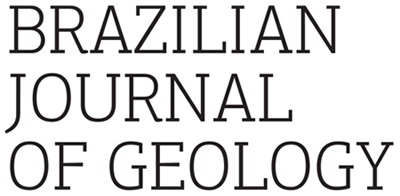
|
ARTICLE Subvolcanic petrology of the Pico dos Três Estados region (SE Brazil): Implications for Alkaline Magmatic Evolution Freitas, Graciano Carlos de Corval, Artur Silva, Júlio Cesar Lopes da Pinheiro, Helena Saraiva Koenow Valente, Sérgio de Castro Abstract in English: Abstract This paper presents a geological study of the subvolcanic bodies present in the Pico dos Três Estados (São Paulo (SP), Rio de Janeiro (RJ), and Minas Gerais (MG)) and its surroundings at the Passa Quatro Alkaline Complex. In this study, we used field-collected data, petrography, and geochemical analysis data. From a more detailed fieldwork, we verified that the region that appeared to present only two lithologies in previous works presented a faciological complex with at least six distinct facies, with emphasis on the phonolitic body that forms the Pico dos Três Estados (2,665 m high). Still regarding fieldwork, we found that there are signs of magma mingling processes in the area. Modeling indicates that 10% of fractional crystallization was able to derive the phonolitic rocks from a trachytic liquid based on the following elements: Y, Nb, Yb, Ce, Sm, Eu, La, Nd, Hf, and Pr. The modal batch partial melting shows the possible mantle sources for the magmatism in this area. This data pointed out the involvement of an enriched mantle source in the La/Yb ratio by at least 16 times more than an Oceanic Island Basalt (OIB)-type mantle. |
|
ARTICLE Integrated hydrothermal evolution of a Botucatu paleodune and a blanketing lava flow from the Serra Geral Group, Uruguaiana Hartmann, Leo Afraneo Leitzke, Felipe Padilha Michelin, Cassiana Roberta Lizzoni Johner, Melissa Lana, Cristiano de Carvalho Abstract in English: Abstract The integrated hydrothermal evolution of the large Santa Otília Paleodune from the Botucatu paleoerg and the cover Catalán Flow from the Serra Geral Group is here evaluated in Uruguaiana, southern Paraná Basin. Methods included satellite images, field surveying, petrography, and U-Pb geochronology of detrital and volcanic zircon. The tops of the compound linear-barchan paleodunes are exposed in the topographic highs. Rhombi and bowls at the top of the silicified sandstone units are significant, as is the poor preservation of eolian layering. The fishbone-shaped dune tops are surrounded by the lavas. The oxidized top of the flow (upper Tier 2) overlies the reduced base (Tier 1), which consists of exposed, massive rocks in creek beds that are light gray-colored and contain small (10 cm) agate geodes and numerous silicified sandstone dikes. The youngest dated zircon grains from the sandstone are 225–300 Ma old (one 175 Ma age), and the main older age peaks are 450–600 Ma (predominant), 900–975 Ma, 1800–1900 Ma, and 2500 Ma; few Archean 2.5 Ga ages. The strongly altered volcanic zircon preserved in the reddened Catalán Flow yields a concordia-intercept age of 137.3 ±7.6 Ma. Complex processes are thus constrained in the evolution of the Botucatu Formation and the first Serra Geral lava flow. |
|
ARTICLE LA-ICP-MS U-Pb zircon dating of rocks of the Jacareacanga Group, Tapajós Domain, Amazon Craton, Brazil Cardozo, Jenny Alexandra Ortega Vasquez, Marcelo Toro, Marco Antonio Galarza Abstract in English: Abstract The Jacareacanga Group comprises mafic to ultramafic schists, metacherts, quartzites, pelitic paragneisses, and amphibolites related to siliciclastic-chemical sedimentation and mafic-ultramafic volcanism. These rocks of the Jacareacanga Group correspond to turbidite-related sediments and oceanic crust basalts of a back-arc or trench basin of the early magmatic Cuiú-Cuiú Arc of the Tapajós Domain in the Amazon Craton. Field data and petrographic analysis support the new zircon U-Pb ages obtained through LA-ICP-MS for the rocks of the Jacareacanga Group. A ± 10% concordance criterion applied, along with an exclusion of ages < 2000 Ma to mitigate interference from later events, such as granitic intrusions. Two pelitic paragneisses yielded 207Pb/206Pb ages between 2008 and 2042 Ma and mica schist ages of ca. 2056 Ma, considered to be the maximum sedimentation age of the protoliths of metasedimentary rocks. Zircon populations from the Rhyacian to the Mesoarchean indicate provenance from adjacent cratonic areas. This study shows that the Jacareacanga Basin was formed during the early Orosirian. The oldest detrital zircon ages support provenance from a magmatic arc basin of a continental margin comprising Rhyacian to Mesoarchean crust. |